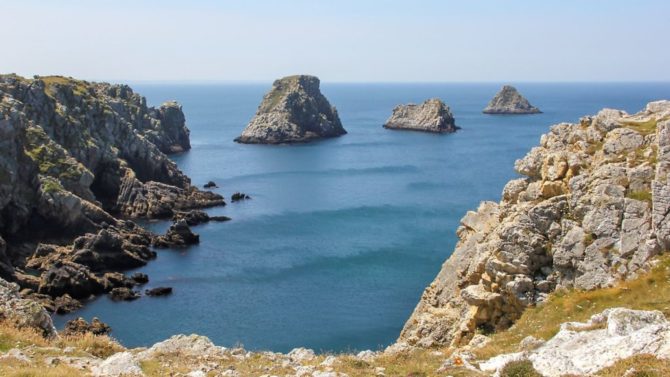Road Trip: Explore Finistère in Brittany


Visit three coastlines in two days with a trip to the northern, western and southern reaches of Finistère, Brittany’s answer to Land’s End.

Day one: Barnenez to Morgat 116km
Why not begin at the end? Where the road peters out at the end of the Kernéléhen peninsula on the northern tip of Finistère (literally ‘end of the earth’) is a final resting place dating back nearly 7,000 years. It is the Cairn de Barnénez, Europe’s largest megalithic burial chamber and one of the oldest surviving structures on Earth. Heaped on a clifftop, this unassuming site predates Stonehenge by 2,500 years, yet you can visit for just a few euros.
From Barnénez, a pleasant drive south brings you to Plouezoc’h. Pick up the southbound D76 to cross the river at Le Dourduff-en-Mer and follow the Morlaix estuary into the town of the same name. Enjoy the colourful timber-framed houses in Morlaix. For a couple of euros you can visit one of the emblematic ‘lantern houses’, which have ornate staircases with bridge-like landings offering dizzying views over their lofty interior courtyards. Duchesse Anne’s house is well worth a visit, and another fine example is the Maison à Pondalez – ‘pondalez’ referring to these staircase bridges, or ponts d’aller.
Once out of Morlaix, take the westbound N12 autoroute to Landerneau. This riverside town would perhaps not warrant a stop but for its fabulous Leclerc outlet – not the supermarket but an art gallery founded by the family behind the chain. Le Fonds Hélène et Édouard Leclerc pour la Culture is an extraordinary exhibition space where, for €8, you can admire great works of art, far from the madding crowds.
After a bite to eat (try Les Petits Plaisirs salon de thé across the road), head out of town and pick up the D770 and then the N165 heading south into the Armorique regional park. At Le Faou turn west and follow the D791 over the cable bridge on to the Crozon peninsula. As the road climbs beyond the trees, look left to see the domed summit of Ménez-Hom, thought to be a Celtic site of sun worship.
The route now shoots along the peninsula spine, via the town of Crozon, and out to its claws. The northern claw is the town of Camaret-sur-Mer, outside of which (in Rue Saint-Pol Roux) standing stones cluster in a marshy field. But park up instead on the southern claw and walk out to the edge of the Pointe de Pen-Hir, a wild, windy and wonderful promontory where the surf lashes the cliffs and the sparkling Atlantic is dotted with rocky outcrops.
Eat at…..Della Spiaggia, for a simple supper of moules, or steak grilled on a hot slate at the table (mains from €8.90, www.dellaspiaggia.fr)
Stay at….Hôtel de la Baie in Morgat (doubles with sea view from €70, www.hoteldelabaie-crozon-morgat.com).

Day two: Morgat to Raguenez 109km
As you bid au revoir to Brittany’s west coast, branch off the D887 after Telgruc Saint-Mer and follow the golden sands through Saint-Nic. Then join the D63 that climbs steadily up the hillside to Locronan, one of the Plus Beaux Villages de France. This handsome community of granite houses softened by wisteria and Breton blue timbers once prospered on the sailcloth industry and now prospers on tourists who potter around its cobbles, buying gifts and galettes. There is a pleasant 45-minute walking circuit through the back lanes and up on to the hillside for wonderful views over the western coastline.
Back on the D63, it is a 20-minute descent through woodland into Plogonnec and on into Quimper, administrative capital of Finistère and the cultural heart of Brittany. Dominated by a magnificent Gothic cathedral, the town is located at the junction (kemper in Breton) of the rivers Stier and Odet, hence its name.
Now is your chance to hit the shops! You might even find a hot chocolate bowl with your name on it, for Quimper is the home of the iconic painted pottery (or faïence) that you see for sale all over Brittany. Pop into the Faïencerie Henriot-Quimper (admission €7, www.henriot-quimper.com) across the river in Locmaria to see more.
Alternatively, visit the Musée des Beaux Arts or stroll around the Jardin de la Retraite off Rue Élie Freron before lunch in one of the cathedral square cafés.
From Quimper, take the N165 and D24 to Pont-Aven. Touristy for good reason, the village is famous for its mills, marina, buttery biscuits and school of painting. Post-Impressionist painter Paul Gauguin put the place on the map in the 1880s with his vibrant canvases of dancing Breton girls and the watermills on the frothy river that gushes through the village. Artists still abound today including Alain Pondeville, whose colourful paintings have even graced the tins of the local Traou Mad biscuit company.
Gauguin, of course, eventually ended up in Tahiti, and so can you. Twenty minutes beyond Pont-Aven, off the D77, is a glorious sandy beach known locally as Tahiti. Sheltered and non-commercial, it is just before the village of Raguénez. Funnily enough, there is also a stunning beach known as Tahiti on Brittany’s north coast, just where the road peters out at the end of the Carentac peninsula, across the water from the Cairn de Barnénez. But that takes us back to the start of the road trip. Or was it the end?
Eat and Stay at…..Ar Men Du, a hotel and Michelin-star restaurant overlooking a beautiful tidal island (menus from €49, doubles from €99, www.men-du.com).
Getting there: Brittany Ferries operates crossings to the nearest ports, Roscoff and Saint-Malo (www.brittany-ferries.co.uk); Barnenez is 40min from Roscoff, about 2hr from Saint-Malo and 6hr 30min from Calais; Rennes airport is 2hr 15min away; The train from Paris Gare Montparnasse to Morlaix takes 3hr.
Tourist information: www.finisterebrittany.com
Share to: Facebook Twitter LinkedIn Email


